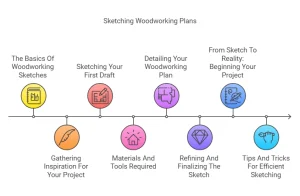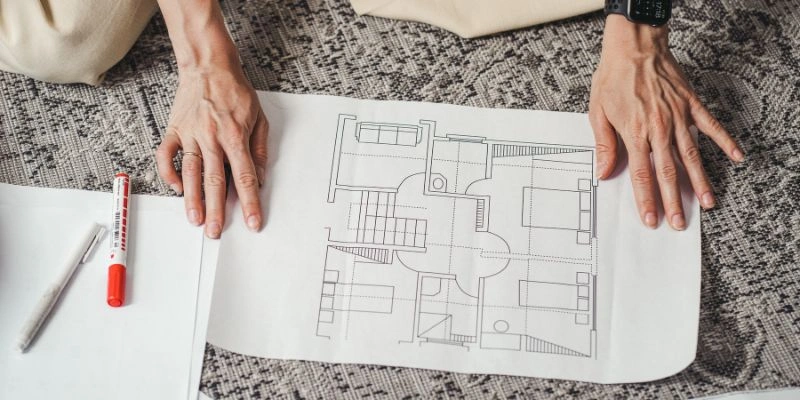To sketch woodworking plans, begin by drafting a rough outline of your project. Then, include measurements, materials, and detailed notes for guidance.
Creating woodworking plans is essential for any successful project. A clear sketch helps visualize your ideas and ensures precision during construction. Whether you’re building furniture or decorative items, a well-thought-out plan saves time and reduces errors. Start by gathering your tools, materials, and inspiration.
Sketching allows you to experiment with designs before committing to them. Take your time to refine your ideas and make necessary adjustments. This process not only enhances creativity but also boosts your confidence as a woodworker. With a solid plan in hand, you’ll be ready to bring your vision to life and tackle any challenges along the way.
The Basics Of Woodworking Sketches
To create great woodworking sketches, start with the right tools. A good pencil and ruler are essential. A graph paper can help keep your lines straight.
Understanding scale is very important. It helps you make your sketches smaller or larger. Use a scale of 1:10 for easy measurement. This means one inch on paper equals ten inches in real life.
Proportions also matter. They ensure your design looks balanced. Always check that all parts fit well together. This will make your project look professional.
Gathering Inspiration For Your Project
Finding the right designs is key for your woodworking project. Explore various styles online. Websites, blogs, and forums can provide great ideas. Look at both modern and traditional designs. Each offers unique features.
A mood board can help visualize your ideas. Use a corkboard or a digital tool. Collect images, colors, and textures that inspire you. Arrange them in a way that feels balanced. This will guide your design choices later.
Don’t forget to consider functionality. A beautiful piece should also be practical. Think about how the furniture will be used. Make sure your designs meet those needs.

Sketching Your First Draft
Start by drawing simple shapes for your project. Use graph paper to keep lines straight. This helps visualize the size and layout.
Include measurements to ensure everything fits well. Think about the purpose of your design. Make sure it is practical and looks good.
Consider the materials you will use. This affects how the design looks and works. Adjust the shape to fit your needs.
Balance is key. Ensure both functionality and aesthetics work together. A good design is both useful and attractive.
Materials And Tools Required
Choosing the right wood type is essential for your project. Different woods have unique properties. Some are strong, while others are easy to carve. Common choices include pine, oak, and maple. Each offers different looks and feels.
Pine is light and affordable, great for beginners. Oak is strong and durable, perfect for furniture. Maple has a fine grain, making it beautiful for visible parts.
Essential sketching supplies include pencils, graph paper, and rulers. Pencils help create clear lines and details. Graph paper aids in scaling your designs accurately. Rulers ensure straight edges and precise measurements.
Using these tools will help bring your woodworking ideas to life. Start sketching with confidence!
Detailing Your Woodworking Plan
Detailing your woodworking plan requires precision and clarity. Start by adding dimensions to your sketches. Clearly label lengths, widths, and heights. This helps visualize the final product.
Next, notate the materials needed for the project. List items like wood types and finishes. Include quantities for each material.
Don’t forget to mention the tools required. Create a separate list for tools like saws, drills, and sanders. Knowing what you need saves time later.
| Materials | Tools |
|---|---|
| Oak Wood | Table Saw |
| Pine Wood | Drill |
| Wood Glue | Sander |
Refining And Finalizing The Sketch
Start by carefully reviewing your sketch for any errors. Look for misalignments and missing details. Check the dimensions to ensure everything is accurate.
After reviewing, gather feedback from others. Ask fellow woodworkers or friends for their opinions. They might notice things you missed.
Use their suggestions to make improvements. Incorporate changes to enhance your design. This step helps create a better final product.
By refining your sketch, you ensure a clearer path for your woodworking project. A polished plan leads to a smoother building process.
From Sketch To Reality: Beginning Your Project
Start by clearing your workspace. A clean area helps you focus. Gather all your tools and materials. Make sure everything is within reach. This saves time during your project.
Next, keep your sketches visible. Place them where you can see them easily. This helps you follow your plans closely. Use a clipboard or a drawing board to hold your sketches. It keeps them safe and neat.
Finally, set up good lighting. Bright lights help you see details clearly. Also, check for any safety gear you may need. Wear gloves and goggles to protect yourself.
Tips And Tricks For Efficient Sketching
Using templates and stencils can make sketching easier. They help create consistent shapes. Start with simple designs. Gradually move to complex patterns. This method saves time and improves accuracy.
Leveraging technology is a smart choice. Use apps for precise measurements. Many programs allow easy adjustments. Some tools even create 3D models. This helps visualize the final product better. Take advantage of these digital resources.

Frequently Asked Questions
How Do I Start Sketching Woodworking Plans?
Begin by gathering your ideas and materials. Use graph paper to outline your project dimensions. Sketch the basic shapes and features first. Focus on proportions and details as you refine your design. This process helps visualize the project and aids in planning cuts and assembly.
What Tools Do I Need For Sketching Plans?
Essential tools include pencils, erasers, and graph paper. A ruler or straightedge helps ensure accurate lines. You might also consider using design software for digital plans. These tools enhance precision and clarity in your woodworking sketches. Investing in quality tools can improve your overall design process.
Can I Use Software For Woodworking Plans?
Yes, design software is ideal for creating woodworking plans. Programs like SketchUp or Fusion 360 offer advanced features. They enable you to visualize your project in 3D and make adjustments easily. Software can also simplify the measurement process and help you accurately plan your cuts.
How Detailed Should My Woodworking Sketches Be?
Aim for a balance of detail and clarity in your sketches. Include essential dimensions, materials, and joinery methods. However, avoid overcrowding your plans with unnecessary information. Clear sketches ensure easier construction and reduce errors. Focus on the key aspects that guide you during the building process.
Conclusion
Mastering the art of sketching woodworking plans is essential for any woodworker. Clear sketches lead to better projects and fewer mistakes. Remember to keep your designs simple and detailed. With practice, your skills will improve. Start sketching today, and watch your woodworking dreams come to life with precision and creativity.

